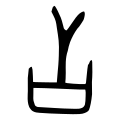|
Radical 135
Radical 135 or radical tongue (舌部) meaning "tongue" is one of the 29 Kangxi radicals (214 radicals in total) composed of 6 strokes. In the Kangxi Dictionary, there are 31 characters (out of 49,030) to be found under this radical. 舌 is also the 134th indexing component in the Table of Indexing Chinese Character Components predominantly adopted by Simplified Chinese dictionaries published in mainland China. Evolution
Variant formsIn the Kangxi Dictionary and in modern Traditional Chinese used in Hong Kong and Taiwan, this radical character begins with a horizontal stroke, while in other languages, it begins with a left-falling stroke.
SinogramThe radical is also used as an independent Chinese character. It is one of the Kyōiku kanji or Kanji taught in elementary school in Japan.[1] It is a fifth grade kanji.[1]
References
Literature
External linksWikimedia Commons has media related to Radical 135. |
|||||||||||||||||||||||||||||||||||||||||||||||||||||||||||||



